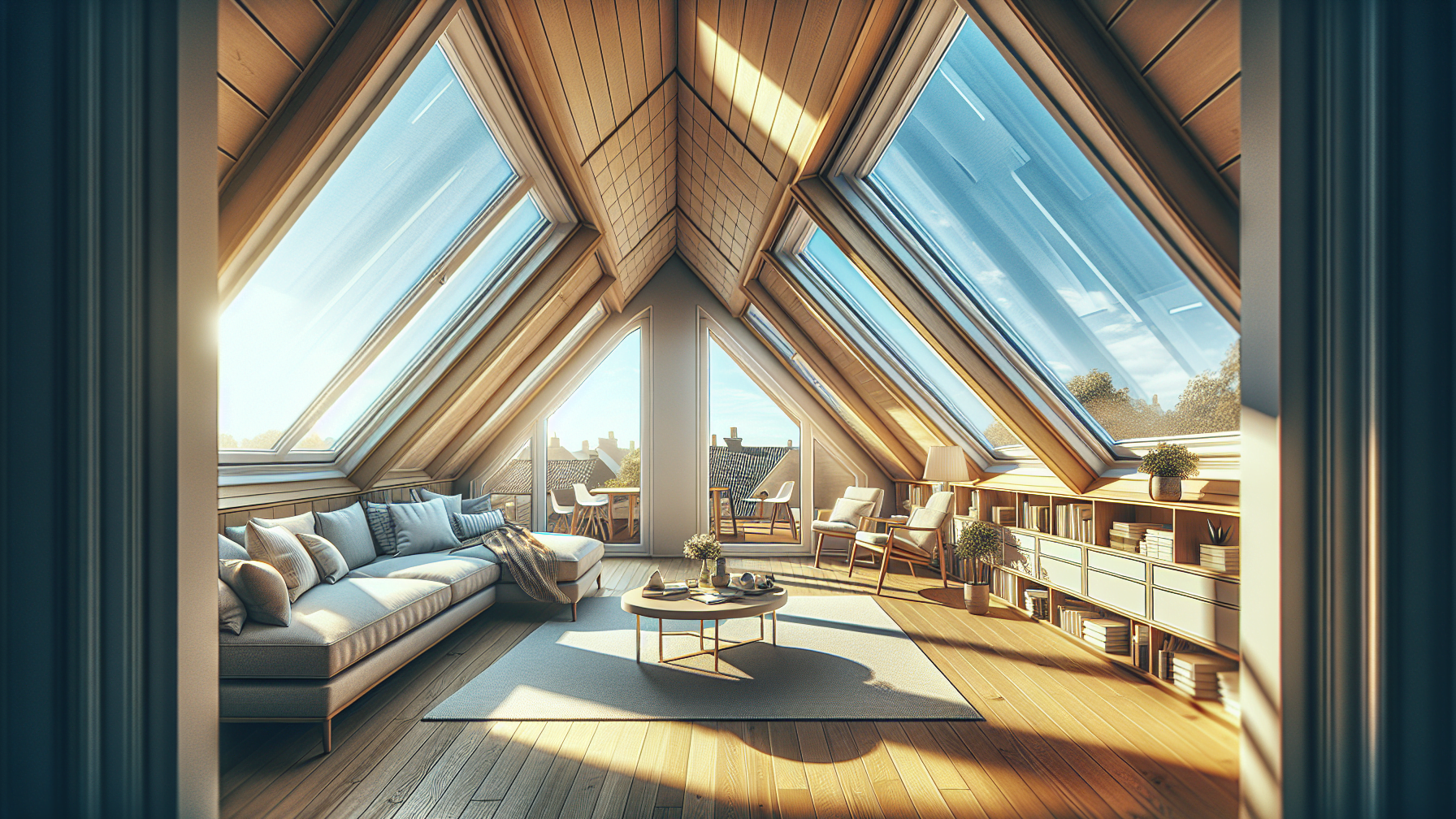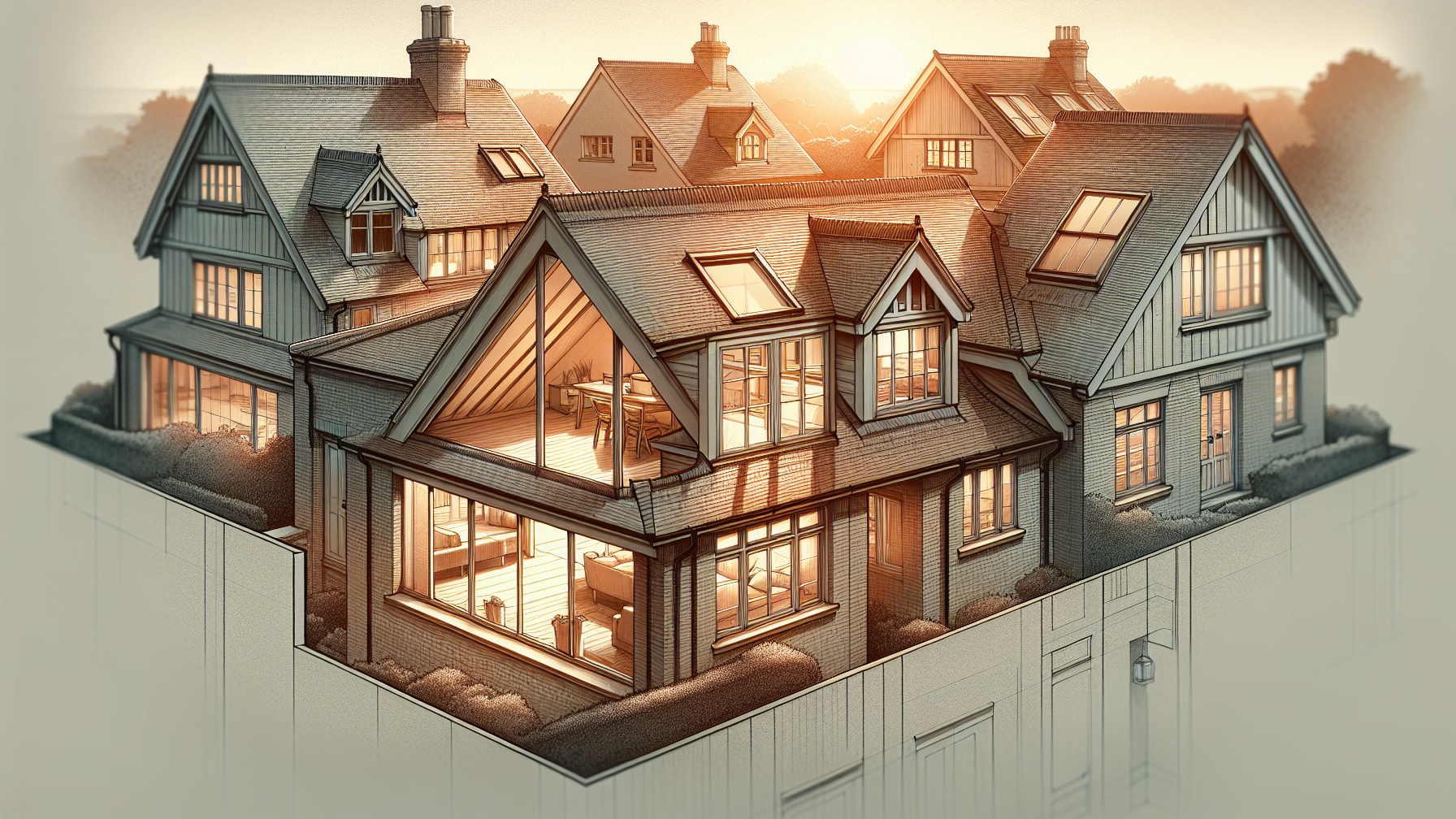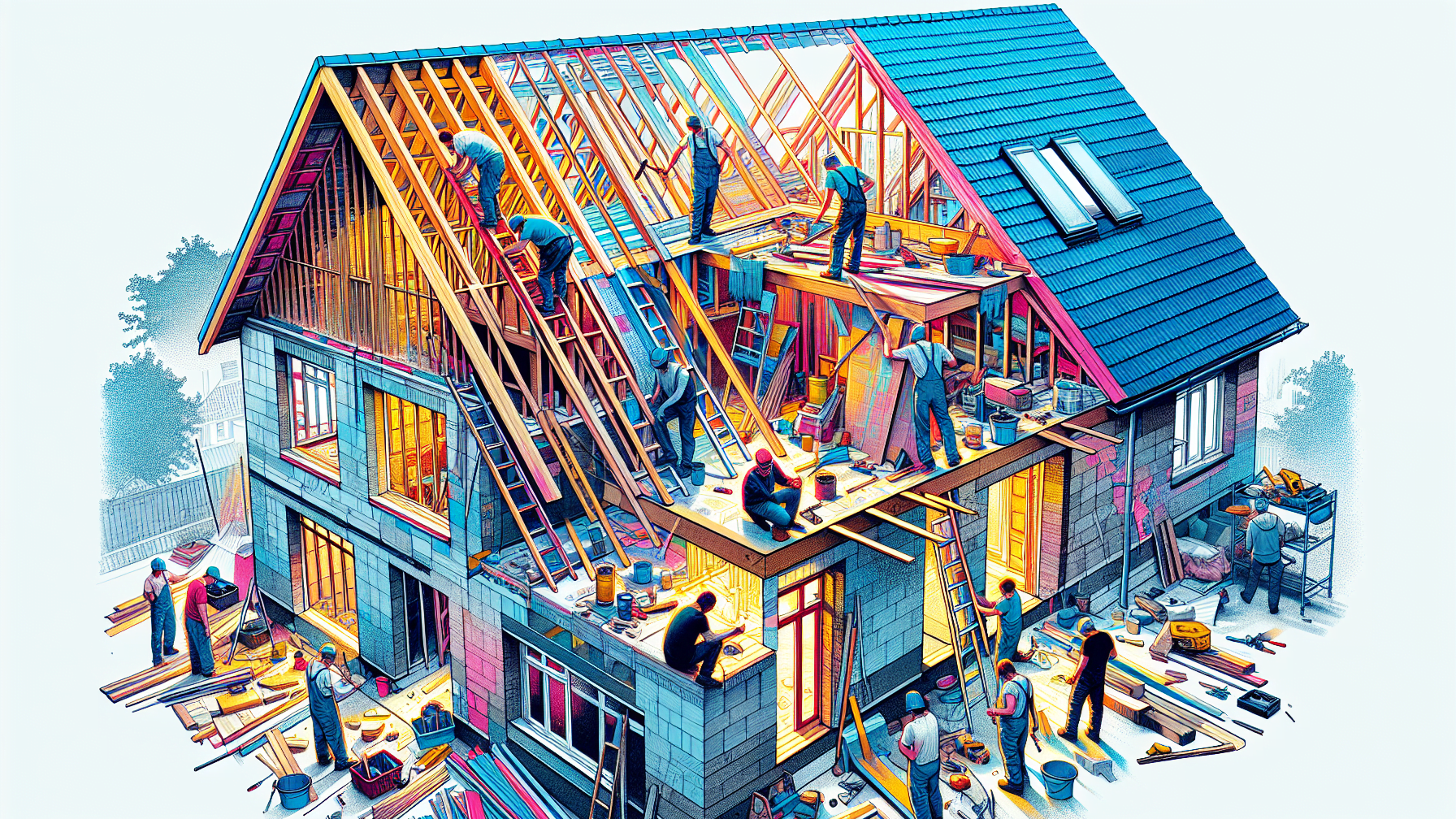Over the years, we have done many loft conversions, transforming attics from dusty storage areas into vibrant new parts of our clients’ homes. We have identified the most popular types of loft conversions, so in this guide, we will talk about the most popular types, including:
- Velux loft conversion
- Dormer loft conversion
- Hip to Gable loft conversion
- Mansard loft conversion
- L-shaped loft conversion.
Each of these conversions can be adjusted to match your property’s structure, budget, and design aspirations.
Understanding Loft Conversion Types
From our own experience, we can easily say that transforming your loft into a livable space is an excellent alternative to relocating. It can release up to 30% more living space that’s currently unused in your attic. Not only can it be less taxing on you than moving, but it is often the more economical solution for adding extra space.
To choose the ideal type of loft conversion for your property, consider familiarizing yourself with various types available, such as Velux, Dormer, Hip-to-Gable, Mansard or L-shaped conversions. The selection should reflect factors such as the configuration and pitch of your existing roof structure, along with financial considerations and any applicable permitted development rights.
Velux Loft Conversions: The Light-Filled Solution

A Velux loft conversion involves adding Velux windows to your attic without altering the roof’s shape. This brings in plenty of natural light and transforms the space into a usable area like a bedroom or office. It’s simpler and usually cheaper than other types of loft conversions because it doesn’t require major construction or change the external appearance of your home. This type of conversion is quick to install and often doesn’t need special planning permission, making it a straightforward way to expand your living space.
Strategically positioning windows or skylights can greatly enhance how much natural daylight floods into your converted loft. To amplify this effect, choose light hues for your walls and floors to cultivate an atmosphere of spaciousness within the area. Do remember that having sufficient headroom in all parts of the loft is essential to fully benefit from a Velux-style transformation.
Dormer Loft Conversions: Creating Extra Headroom

Seeking additional headroom and room to move within your loft? Dormer loft conversions are one of the most popular loft conversions in the UK. A dormer loft conversion involves extending the existing roof of your house to create more vertical space and adding a windowed structure that projects outward. This not only increases the usable floor area and ceiling height in your attic but also improves natural light and ventilation. It’s ideal for adding extra rooms like bedrooms or offices. The exterior of the dormer can be designed to blend with your house, enhancing both space and property value. This type of conversion usually requires planning permission due to changes in the roofline.
The flat roof type stands out as the UK’s favourite option among dormer conversions. Typically, a flat roof dormer is constructed at the back of a terraced house (read dormer), optimally expanding the space. These flat roof dormers have garnered popularity among property owners keen on fully utilizing their loft conversion potential.
Regardless of house type, Dormer conversions can be tailored to effectively amplify available floor space and even allow for supplementary additions, such as extra bedrooms within your home’s structure.
Hip to Gable Loft Conversions: Expanding Sloping Roofs

A hip to gable loft conversion involves extending the sloping ‘hip’ side of your roof into a vertical ‘gable’ wall to maximize the interior space of the loft. This conversion is especially suitable for houses with hipped roofs, where the roof slopes inward on all sides. By extending one or more of these sides, you gain more vertical space and can significantly enlarge the usable area of the attic. Due to the change in roof shape, a hip-to-gable loft conversion typically requires planning permission.
What does hip-to-gable achieve? It considerably boosts headroom as well as practical living space within the loft, thereby maximizing usable space throughout. This type of conversion is ideal for adding more substantial rooms like a master bedroom or a spacious home office For those aiming to convert their tight and angled roofing space into an expansive and upright environment, opting for this particular style of loft conversion is ideal!
Mansard Loft Conversions: The Classic Space Enhancer

A mansard loft conversion involves changing the structure of your roof to create a nearly vertical wall from the sloping roof and adding a flat roof on top. This significantly increases the usable space in your attic, making it feel more like an additional storey than just a converted loft. It’s great for adding multiple rooms or a large, open-plan space. Mansard conversions usually require planning permission because they alter the shape of the house. They are popular in larger cities like London, where maximizing living space is essential.
The main goal of undertaking a Mansard loft conversion is to capitalize on the potential space within your home. If you’re aiming to expand either the front or back portion – or possibly both – of your dwelling, opting for a mansard loft conversion can elevate the functionality of your living quarters significantly.
L-Shaped Loft Conversions: The Mid-Terrace Marvel
An L-shaped loft conversion is a design used mainly in houses with an L-shaped roof, like many Victorian terraces. This type of conversion takes advantage of the space over the rear extension of the house, as well as the main part of the loft, creating a large, versatile area. It’s particularly effective for adding substantial space, often enough for two rooms or a large, open-plan layout. This conversion can significantly enhance the functionality and value of a home. It’s more complex and typically more expensive than simpler conversions but offers a greater increase in living space.
An L-shaped loft offers additional floor space for a variety of uses. Whether you desire a large master suite, a snug study room or an energetic play area for kids, this type of conversion allows you to realize the potential of your loft in fulfilling those needs.
Planning for Your Loft Conversion
After selecting the ideal type of loft conversion for your home, you can start the planning stage. Many loft conversions can proceed without needing to submit a formal planning application because they come under permitted development rights. Nevertheless, understanding when obtaining planning permission is necessary, and what is defined as permitted development is crucial.
When Is Planning Permission Required?
If loft conversions fall outside the specific conditions outlined for permitted development, planning permission becomes necessary. This will be the case if front-facing windows are added or if the conversion exceeds the volume allowance for permitted development.
Similarly, those residing in flats, maisonettes, or homes within conservation areas will typically require planning permission when undertaking a loft conversion that alters roof space. Please note that concerns regarding the effects on neighbouring properties often lead to the rejection of planning applications for loft conversions, especially in conservation areas where they are examined more closely. If you’re not sure if you need planning permission, please drop us an email, and we’ll help you out.
Understanding Permitted Development Rights
Loft conversions can be executed with less bureaucratic hassle thanks to permitted development rights, which negate the need for a full-fledged planning application when certain conditions are met. Under these rights, terraced homes are allocated up to 40 cubic meters of additional loft space, while detached and semi-detached houses have a larger allowance of 50 cubic meters.
To ensure compliance with permitted development, pay attention because:
- The extension should not surpass the plane of the existing roof slope that faces any highway.
- The peak height must not exceed that of the existing roof.
- A minimum setback distance from the original eaves, following along with the roofing plane, must be maintained at no less than 20 centimeters.
Although it is not an obligation by law, securing a Lawful Development Certificate is wise as this serves as validation that your construction abides by legal parameters.
Maximising Your Loft Space
Having determined the kind of loft conversion and dealt with the planning aspects, what’s next in maximizing our loft space? The answer revolves around focusing on design enhancements for improved utility as well as ensuring an abundance of natural light and airflow.
It’s time to jump into these vital components that will elevate your loft from just a regular living space to something truly special!
Design Considerations for Added Functionality
The success of a loft conversion heavily relies on its design. Here are some ingenious approaches to consider in order to enhance the use and appeal of a loft space:
- Opting for built-in storage options such as custom wardrobes, under-eave compartments, and integrated shelving helps efficiently use the distinctive shapes and challenging areas typical of lofts.
- Implementing design strategies that create an impression of more vertical space is beneficial. Tall bookcases or drapery reaching from floor to ceiling can achieve this effect.
- Incorporating architectural features like skylights or Juliet balconies also contributes distinctiveness to the converted area.
Such thoughtful design elements not only enhance functionality but also elevate the overall beauty of your loft conversion.
Embracing a minimalist interior decorating scheme will maintain an airy atmosphere throughout your newly transformed attic. To achieve minimalism with practicality, consider these suggestions:
- Employ mirrors judiciously around the room, which reflect both natural light and views across spaces, thus broadening visual dimensions.
- Choose furniture that does double duty. Examples include couches converted into beds or tables offering concealed storage capacity.
- Thoughtful positioning of furnishings beneath angled ceilings – or applying separators – can optimize living space efficiency in a creatively adapted attic area.
Incorporating Natural Light and Ventilation
Ensuring a loft space is filled with ample natural light and adequate ventilation is essential for creating an environment that’s both welcoming and pleasant. By installing sizable Velux windows, you can inundate your loft conversion with daylight while maintaining the exterior facade of your home intact. Windows on the side should have frosted glass to maintain privacy and must be positioned sufficiently high off the floor – typically no less than 1.7 meters.
Adding unique elements like a Velux Cabrio Balcony can bring versatility as well as elegance, along with a hint of alfresco living inside your home. Loft conversions featuring gabled dormers that include expansive windows or French doors are excellent ways to enhance natural lighting within the area, making it feel more spacious and luminous.
Loft Conversion Benefits and Potential
Loft conversions are not only about augmenting your home’s living space and visual charm. They also present substantial advantages that can amplify both the value and utility of your house.
We will explore the ways in which transforming your loft can elevate the monetary value of your property while simultaneously creating spaces that enrich your way of life.
Boosting Property Value with a Loft Extension
Are you aware that a skillfully executed loft conversion can raise the value of your home by around 20%, and even more so – up to 24.5% in areas of high real estate demand such as London? Opting for a Dormer loft conversion is an economically viable choice, providing substantial additional living space without significantly expanding the budget, making it very appealing to prospective purchasers.
The extent to which a property’s value is elevated due to a loft conversion hinges on both existing market trends and the particular attributes of the home. Do take into account that conversions maximising attic utility or incorporating roof windows to allow ample natural light stand out on the market by boosting both allure and prospective resale value.
Creating Lifestyle-Enhancing Spaces
The flexibility of loft conversions presents a significant advantage, as they can be customized to suit the specific tastes and requirements of individuals or families. Lofts can be adeptly converted into various types of rooms, including:
- Bedrooms
- Home gyms
- Playrooms
- Areas for entertainment
- Distinctive spaces that resonate with an individual’s way of life
Embedding personal design flair within a loft conversion is crucial in fashioning an area that not only serves its purpose but also aligns with the homeowner’s visual desires.
Real-Life Loft Conversion Examples
Exploring actual cases of loft conversions can provide a clear picture of their potential to turn your attic into practical and visually appealing living spaces. Despite the theoretical allure, seeing these transformations in reality truly demonstrates how effectively they can enhance the usability and aesthetics of an underutilized loft.
Case Study: A Bright and Airy Velux Conversion
A Velux conversion in a detached house ingeniously repurposed the formerly idle attic area into a vibrant and well-lit living space, which now encompasses two freshly created bedrooms, an accommodating bathroom, and an expansive landing zone. These rooms are adorned with warm and neutral tones that accent their open and luminous ambience.
In maximizing the use of living space, the master bedroom is outfitted with a built-in wardrobe alongside a dedicated dressing section. To elevate the home’s aesthetic appeal and contribute to its distinct charm, an oak staircase was fitted as a tasteful addition to the residence.
Case Study: A Spacious Dormer Conversion in a Semi-Detached Property
Transforming a semi-detached home, the introduction of a dormer conversion within the attic area provided an expanded living environment complete with an added bedroom. The suitability of this property for such enhancement was due to its pre-existing loft that boasted ample headroom, ideal for accommodating a pitched roof dormer.
This modification yielded considerable additional floor space and furnished the residence with another bedroom, thereby substantially improving its utility. A window positioned at the rear elevated both the spaciousness and illumination of this newly crafted bedroom.
Key Takeaways
- Loft conversions can unlock up to 30% more space and are a cost-effective, less stressful alternative to moving, with various types such as Velux, Dormer, Hip to Gable, Mansard, and L-shaped conversions each offering different benefits and suitability based on home design and budget.
- Planning permission for loft conversions hinges on compliance with permitted development rights; for instance, volume allowances differ for terraced and detached/semi-detached homes, and factors like the position of dormers and roof extensions are regulated to minimize the impact on neighbouring properties.
- A well-executed loft conversion can enhance a home’s value by up to 20% and create multipurpose living spaces that cater to personal preferences, such as additional bedrooms, home offices, or entertainment areas. These spaces should emphasize natural light, ventilation, and smart design choices.
To sum up, transforming your home’s unused attic through a loft conversion can substantially enhance your living area. Whether you choose Velux, Dormer, Hip to Gable, Mansard or L-shaped conversions, each brings distinct advantages that contribute to the appeal and functionality of your space. Key factors such as permitted development rights and planning permission need careful consideration. Effective use of design elements like natural light can make all the difference in elevating the success of your loft project. Don’t delay – embark on realizing the full potential of your loft with a well-planned conversion now!
Frequntly Asked Questions
What are the different types of loft conversions?
Five primary types of loft conversion exist, namely: roof light/Velux conversions, dormer conversions, hip-to-gable conversions, mansard conversions and L-shaped.
What is the cheapest type of loft conversion?
Opting for a Velux conversion is the most budget-friendly choice when considering a loft conversion. This process entails installing roof windows into your existing loft space to allow for natural light and improved airflow, thus presenting an uncomplicated and economical solution.
This type of loft renovation stands out as an affordable alternative to expand the living area within your residence.
What is a Type 3 loft extension?
A Type 3 loft extension offers an expansion that includes a complete second-floor addition, featuring living accommodations within the loft on the third floor. This design is carefully crafted to blend seamlessly with the original materials and structure.
Such an extension provides extra living space situated under a pitched roof, making use of the loft area for added room.
What lofts Cannot be converted?
The potential for a loft conversion exists in many homes. This is contingent on various aspects such as the ridge height, the amount of space accessible, and any limitations due to conservation or heritage considerations.
Typically, if the vertical distance from the loft floor to its apex – the highest point – is under 2.2 meters, it may not be conducive for a conversion.
Do all loft conversions require planning permission?
Loft conversions that fall outside the parameters of permitted development will necessitate planning permission. Conversely, those meeting these conditions do not require such authorization.
